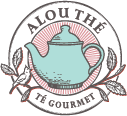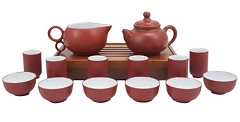- Tea
- Water
- Measuring spoons or digital scale
- Thermometer
- Clock or “timer”
- Kettle
- Infuser or strainer
- Bowl
Tea
The type of tea that we will use will depend on the time of day, an occasion, guests taste or the snack that will be accompanying the tea. One teaspoon is used for every 8 ounces of water, per person. For example, if the tea to be used is a delicate tea such as white tea or a herbal tea, larger quantities (1 ½-2 tbsp) can be used. Although this can vary depending on the person’s taste. If the tea strands have large leaves, we will use more strand volume and prepare the tea with smaller leaves. The more split or small the leaves are, they will give a better color and more intense flavor. The strands, dehydrated or rolled leaves, when in contact with water, expand and hydrate.
Water
Water is a very important element since approx. 98%. of tea is water. The better the water quality, the better the tea. If you use tap water it is important that you measure chlorine content, since if it is too high it will ruin the a good tea preparation. Lu Yu said that the best water for making tea is from the mountain spring. This is because spring water contains more oxygen so it is better for making tea. If we do not have spring water, we will use mineral water or filtered water.
Measuring spoon
Measuring spoons are very simple to correctly measure tea. Also the digital scale turns out to be very accurate as long as it is calibrated. The advantage is that it offers varying options to measure in different metric units such as ounces or grams.
Thermometer
The thermometer is used to measure the temperature of the water. The recommended temperature depends on the kind of tea. If the tea strands are infused in higher than required water temperature, it is likely that the leaves will burn, especially if it is a delicate tea. If the tea strands are infused in lower water temperature, it is likely that the tea will not infuse correctly, and it will lack color and flavor.
Clock
The clock or “timer” is used to measure the threads infusion time in the water. If the strands are in contact with water for longer than recommended, a bitter and astringent liquor will be obtained. If the infusion time is shorter than recommended, a liquor lacking aroma and flavor will be obtained.
Kettle
There are different types of teapots, with specific characteristics for each type of tea. Teapots made of porous material such as terracotta or unglazed clay are recommended to be used only for certain teas, since with their use and over time they acquire the flavor of the liquor. For this reason, these kettles should not be washed with detergents or chemicals, they are only rinsed with water, since these alter the aroma and flavor of the liquor. The used teapot is cured, which makes the flavor more and more pleasant to the palate.
Yixing Kettles – Made of clay from Yixing in the Jiangsu province of China. These have been manufactured since the Song dynasty in the 10th century. Given the type of material, they absorb a small amount of tea during use. After prolonged use, they develop a coating that retains the color and flavor of the tea. They should be rinsed with water only and allowed to air dry. The most recommended teas for this teapot are oolong and pouchongs.
Ceramic Kettles – Made of ceramic with thick walls and of various shapes. Ceramic has low heat transfer, so it maintains the temperature of the water better than other types of materials. The most recommended teas for this teapot are Pu Erh.
Porcelain Kettles – Made of traditionally white ceramic product, of Chinese origin in the 7th century. Its walls are thinner than ceramic ones, but they are more resistant and have low heat transfer, so it maintains the temperature. The most recommended teas for this teapot are white and green.
Japanese Kettles – Made of different materials, usually ceramic, and the difference is their shape. The usual feature is a side handle, which is held with both hands. The most recommended teas for this teapot are green.
 Iron Kettles – Made of cast iron, also known as “Tetsubin”. These appeared in Japan in the middle of the 17th century. They were considered a symbol of social status. Due to their composition, they have great heat transfer, so the tea liquor does not lose temperature quickly. Its interior is enameled to prevent oxidation and transfer of metallic flavors. They should be rinsed with water only and allowed to air dry. Ideal only for teas that require high temperatures.
Iron Kettles – Made of cast iron, also known as “Tetsubin”. These appeared in Japan in the middle of the 17th century. They were considered a symbol of social status. Due to their composition, they have great heat transfer, so the tea liquor does not lose temperature quickly. Its interior is enameled to prevent oxidation and transfer of metallic flavors. They should be rinsed with water only and allowed to air dry. Ideal only for teas that require high temperatures.
Silver Kettle – Made of silver, modernly coated on the inside with Teflon or ceramic to avoid metallic tastes. In the past they were popular in England and France, being a status symbol. Silver has the disadvantage that it has a high thermal conductivity, which makes it difficult to handle, since we can burn ourselves. The most recommended teas for this teapot are green and black.
Glass Kettle – Made of glass, of different thicknesses and generally thin. Heat loss is less than metal. The great attraction of glass is to be able to observe the tea and the liquor color. The most recommended teas for this teapot are white, green and blooming teas.
Infuser – Is a type of strainer or net where tea strands are placed. In such a way that it facilitates the removal of threads when infusion time has been completed. Infusers come in different shapes, materials and sizes. The wider the infuser space, the better, since when hydrated the strands expand. Some infuser materials are stainless steel, bamboo, plastic, etc.
Cup – Is the container with a handle, used to drink liquid. For a better appreciation, it is recommended for cups to have a white interior and straight walls. Bowl-shaped cups, without a handle, are called bowls, which are recommended for better enjoyment of tea aroma. In some tea-consuming countries, other special cups are used:
Gaiwan – is “wan” without handle, “gai” with a lid and saucer. Invented in the Ming dynasty in China in the 14th century. It is made of clay, porcelain or glass. These are not made of metal because this material has high thermal conductivity and we can burn ourselves. These are recommended for teas with a longer infusion time, since the threads remains inside. The lid prevents them from slipping out. Most recommended teas are oolong, green and puerh. CTC teas are not usually brewed in Gaiwan due to the fact that leaves are very small and would leak, plus these teas are of lesser quality and cannot be re-infused.
Gong Fu– “to make tea with an effort” is a set of utensils used in Chinese tea ceremony. This involves a presentation and preparation of the tea ritual. Several components are used on a wooden tray, highlighting a tall glass to appreciate the tea’s aroma. It is usually used for high-quality, aromatic teas that can be re-infused. The most recommended teas to use are high quality ones.
How to prepare the tea?
- Choose the tea.
- Have ready the kettle, infuser, “timer”, thermometer, water, measuring teaspoon, and cup.
- Measure the tea amount.
- We measure water. We heat it to the suggested temperature depending on the tea type.
- Pour hot water into the kettle, which must have the infuser (strainer) inside with the tea.
- We let the tea infuse at the suggested time.
- We remove the infuser (strainer) with the tea.
- We serve in the cup or bowl and taste it.
Amount, water temperature, and infusion times for each tea
| Tea TYpe |
6oz* QTY |
Water Temperature |
Infusion TIme |
| White | 2 tsp. | 175° F /79° C | 3 min |
| Green | 1 tbsp. | 175°-185° F /79°-85° C | 3 min |
| Oolong | 1 tbsp. | 195°-212° F /90°-100° C | 4 min |
| Black | 1 tbsp. | 212° F /100° C | 5 min |
| Pu Erh | 1 tbsp. | 212° F /100°C | 3 min |
| Flowering Tea** | 1 piece | 212° F /100°C | 3 min |
| Herbal Tea | 1 tbsp. | 195-205° F /90-100° C | 5 min |
*The suggested amount is for hot tea. If you will make it cold or Iced Tea you need to use double the amount.
**A piece of flowering tea yields about 3 cups or re-infusions.










